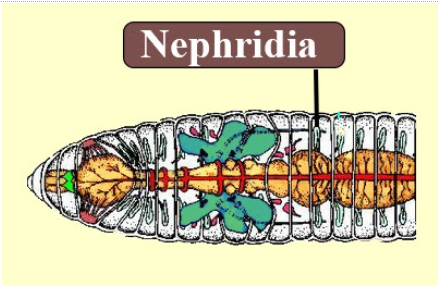
Excretion in most annelids takes place by
(a)Kidneys
(b)Flame cells
(c)Nephridia
(d)Both B and C
Answer
484.5k+ views
Hint: In many invertebrate animals a tubule that usually opens into the body cavity and the other to the exterior, acts as an organ of excretion i.e. used to remove metabolic wastes from an animal's body. This organ usually has ciliated or flagellated cells and absorptive walls.
Complete answer:
The nephridia occur in pairs on each segment on the annelid and are an invertebrate organ present in annelids which function as waste removal from the annelids body. The nephridia pump water carrying toxins from food, ions, and useless hormones out of the organism by directing them down funnel-shaped bodies and then removed out at the nephridiopore. The primary waste or urine produced by filtration of blood is modified into secondary urine through selective reabsorption by the metanephridium lining cells. It is also found in arthropods and Mollusca.
In some annelids, the nephridium tubule does not open into the body cavity but ends internally in a cluster of cells known as solenocytes or flame cells. The characteristics of some annelids that allies them with other non-segmented phyla that have no true body cavity are characterized by the possession of these cells. These kinds of annelids belonging to phyla are primarily aquatic and known ones excrete ammonia.

So, the correct answer is option ‘Nephridia’.
Note: Kidneys are present in humans and are a part of the excretory system. Flatworms have flame cells used as excretory organs which help to excrete metabolic waste by the constant beating of cilia. They are also found in rotifers and nemerteans.
Complete answer:
The nephridia occur in pairs on each segment on the annelid and are an invertebrate organ present in annelids which function as waste removal from the annelids body. The nephridia pump water carrying toxins from food, ions, and useless hormones out of the organism by directing them down funnel-shaped bodies and then removed out at the nephridiopore. The primary waste or urine produced by filtration of blood is modified into secondary urine through selective reabsorption by the metanephridium lining cells. It is also found in arthropods and Mollusca.
In some annelids, the nephridium tubule does not open into the body cavity but ends internally in a cluster of cells known as solenocytes or flame cells. The characteristics of some annelids that allies them with other non-segmented phyla that have no true body cavity are characterized by the possession of these cells. These kinds of annelids belonging to phyla are primarily aquatic and known ones excrete ammonia.

So, the correct answer is option ‘Nephridia’.
Note: Kidneys are present in humans and are a part of the excretory system. Flatworms have flame cells used as excretory organs which help to excrete metabolic waste by the constant beating of cilia. They are also found in rotifers and nemerteans.
Recently Updated Pages
Glucose when reduced with HI and red Phosphorus gives class 11 chemistry CBSE

The highest possible oxidation states of Uranium and class 11 chemistry CBSE

Find the value of x if the mode of the following data class 11 maths CBSE

Which of the following can be used in the Friedel Crafts class 11 chemistry CBSE

A sphere of mass 40 kg is attracted by a second sphere class 11 physics CBSE

Statement I Reactivity of aluminium decreases when class 11 chemistry CBSE

Trending doubts
10 examples of friction in our daily life

One Metric ton is equal to kg A 10000 B 1000 C 100 class 11 physics CBSE

Difference Between Prokaryotic Cells and Eukaryotic Cells

State and prove Bernoullis theorem class 11 physics CBSE

What organs are located on the left side of your body class 11 biology CBSE

How many valence electrons does nitrogen have class 11 chemistry CBSE




